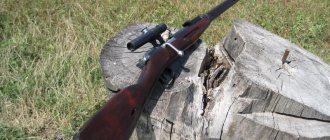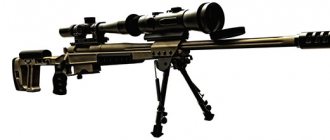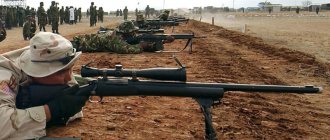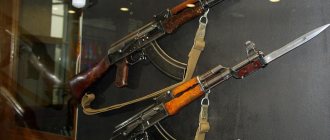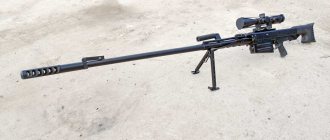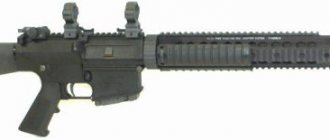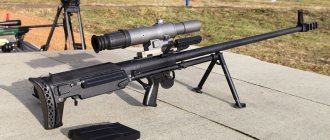The Mosin rifle, also popular as the famous “three-line rifle,” was the main weapon of the 1917 revolution, as well as the Great Russian War. Specifically, the Mosin rifle of the 1891 standard is considered to be one of the most famous examples of Russian weapons. The royal three-ruler took a role in the Russo-Japanese and later the First World War.
The Russian “three-line”, made before the twentieth century, remained for decades a modern and reliable weapon for a fighter, and was one of the first Russian models adopted by the army. Now mmg Mosin rifles can be seen in museums. There are also existing modifications of the rifle, not only in Russia, but also abroad. The design changed, the drawings were modified, the technical properties were changed, but the principle of the weapon remained the same. What is the creation story of the Mosin rifle? We offer an overview of the famous weapon.
Creation Story
The Mosin rifle was developed during a period of rapid growth in technology and science, when the advent of smokeless powder made it possible to switch to smaller calibers. And thanks to the development of weapons technology, it became possible to replace single-shot systems with magazine-fed systems. Naturally, our homeland was also in the process of developing weapons. Drawings and standards of small arms were created.
custom_block(1, 63481091, 1013);
As a result, the Russian army was presented with two systems of magazine-type rifles to choose from - Belgian, Leon Nagant, also Russian, Captain S.I. Mosin. Tests showed that the Belgian rifle was better than the Russian one. But senior management took into account that:
- the Belgian rifle had twice as many misfires;
- the Russian rifle was cheaper and easier to manufacture.
The generals eventually compromised: the Mosin rifle was adopted by the Russian army in 1891, but it was equipped with a Nagant 5-round magazine design. Along with the rifle, a new three-line cartridge (7.62 mm) was also adopted for service. The Bala rifle was accepted as a three-line rifle, and the soldiers dubbed the weapon “three-line.” This weapon received the name Mosin back only in Russian times, when it was modernized in 1930. The Russian three-line rifle has always been called “Mosin-Nagan” abroad.
The Bad
How many times have they told the world that converting a weapon with a classic layout into a “bullpup” will do nothing but reduce the overall length. Judge for yourself - the bolt ends up almost under the shooter’s cheek, and reloading requires gymnastic exercises or a change in the grip of the weapon, the muzzle cut (and with it the flash, which is quite strong in a three-ruler) approaches the shooter’s face, and the pulls from the new trigger inevitably worsen the already the descent of the “three” is far from ideal. But do you think this stops anyone?
MNAR from CBRPS
Our review includes a high-tech aluminum alloy stock from the small American company CBRPS and an extravagant wooden stock from Utah Custom Guns.
It’s the same in comparison with the Mosin rifle (photo source)
Both conversions allow the installation of modern optics thanks to Picatinny rails, which will undoubtedly attract attention to the shooter at the firing line. However, this is precisely why such tuning, as a rule, is started. And convenience is all purely personal preference.
The brainchild of Utah Custom Guns
Inventor of the “three-line”
The history of the creation of the “three-line” was complex. Several designers played a role in the development of the best repeating rifle in the world, but the most significant contribution was made by Sergei Ivanovich Mosin. History was unfair to him in almost every way, because during his lifetime his rifle did not bear the name Mosin, this greatly disappointed the designer.
The inventor Mosin was born in the Voronezh region in the village of Ramon. He graduated from the military and artillery school, artillery academy. In 1875 he became the head of the tool workshop of the arms factory in Tula. By 1880, he was already developing single-shot rifles and was an expert in gunsmithing. In 1894 he became the head of the Sestroretsk arms factory.
Russian weapons are not for sale
In 1885, agents of the Parisian armory tried to buy the drawings of the rifle he was designing from Mosin. The French offered the gunsmith first 600 thousand francs for them, and then a million. This was a colossal sum for those times: Mosin could spend the rest of his life in luxury. However, he resolutely refused the lucrative offer, saying that he was Russian and worked only for the good of Russia.
Article on the topic
"Hell's Mower": the most "bloodthirsty" machine gun in the history of wars
Cartridges for the “three-line”
The cartridge was created by the Russian designer Veltishchev by analogy with the French cartridge from the Lebel rifle, caliber 8x56 mm R. It used:
- blunt-pointed jacket bullets;
- smokeless powder charge;
- a sleeve with a protruding bottle-shaped rim.
The mechanism of a sleeve with a rim, which is already outdated, was adopted due to the low level of development of the Russian industry - the tolerances used are the least strict. This determined the economic and military base.
Adoption
The 1891 standard gun (caliber 7.62) was put into service in 3 variants (practically they were distinguished only by the barrel length):
1. Infantry rifle - longer bayonet and barrel.
2. Dragoon (cavalry) rifle - the barrel length is shorter, and the method of attaching the belt has been changed.
3. Cossack rifle - there was no bayonet and there was a smaller barrel.
The bayonet for the rifle was adopted from a slightly outdated standard - tetrahedral, needle-shaped, with a tubular coupling attached, which was put on the barrel. The bayonet had a square cross-section with small fullers along the edges; when disassembling the weapon, the tip, sharpened to a plane, could be used as a screwdriver.
custom_block(1, 45176399, 1013);
The main drawback of the system, which was only corrected in 1938, was that the bayonet had to always be worn in a combat position, attached to the rifle; disassembly was not intended. “Three-line soldiers” took aim (not counting the Cossack one) with a fixed bayonet. If the bayonet was disassembled and removed, the balance of the gun was upset - the bullets flew past the target. In addition, over time, the bayonet fastenings led to loosening, and shooting accuracy deteriorated. The defect was corrected only in the 1930 modification.
The guns of earlier models were distinguished by the absence of barrel linings and by a barrel that was open at the top along its entire length. Since 1894, wooden top pads have been used to protect the shooter's hands from burns. At the time the weapon was accepted into service, Russian enterprises were not yet able to begin producing new rifles, so the initial order was placed in France, in the town of Chatellerault.
custom_block(5, 28737069, 1013);
It was only in 1893-94 that the rifle went into serial production and was established near St. Petersburg at the Sestroretsk arms factory under the management of Mosin, and in Izhevsk and Tula a little later. During the First World War, rifles had to be ordered from the USA to make up for losses at the front. Orders in 1916 are located at Westinghouse and Remington factories. After 1917, most of the rifles remained in the United States, where they were sold or used for initial soldier training in the army.
The Ugly
Classic tuning of the “three-line” - obrez. If you think that Americans are alien to the sense of beauty in the form of an angle grinder cutting a trunk, then you are mistaken. Look, fortunately, American laws, with certain restrictions, allow such misanthropic surgery on long-barreled weapons.
What if you don’t have an angle grinder on your household, or don’t want to bother with registering a “short-barreled rifle” (an American legal term for a weapon of a certain class - Ed.)? Just see for yourself what the poor rifle has been reduced to, the Herods...
As you can see, “improving”, also known as tuning, can be of a purely aesthetic or practical nature, or simply a banal “but I can do this, and it doesn’t matter why.” In any case, attempts to improve the platform can be very interesting, although not always reasonable...
Technical properties
Standard rifle 1891/1930 is a bolt action repeating rifle with a twist lock.
Technical properties:
- Caliber - 7.62 mm.
- The total weight without cartridges with a bayonet is 4.5 kg.
- The total length without bayonet is 114 cm.
- The total length with the bayonet is 166 cm.
- The shape of the paresis is rectangular.
- Number of grooves - 4.
- Magazine capacity - 5 rounds.
- The weight of the clip including cartridges is 122-132 g.
Shooting can be carried out with standard cartridges with heavy and light bullets, with incendiary, tracer and armor-piercing bullets.
Well done bayonet
The combat manual of the Red Army stated: “The ultimate combat mission of the infantry in an offensive battle is to defeat the enemy in hand-to-hand combat.” In the Red Army, they took care of cartridges and soldiers rarely went to shooting ranges, but they did not spare time for exercises with a bayonet. The so-called “troika” was practiced: injections, blows with the butt and repulses. The soldiers honed their acquired skills in training battles using carbines with soft tips. As a result of this “school,” our infantrymen felt most confident in hand-to-hand combat. The tetrahedral needle bayonet easily pierced even a thick layer of clothing and inflicted, if not fatal, then poorly healing wounds on the enemy. They had great depth and a small entrance hole. After pulling out the bayonet, the edges of the wound immediately converged; due to infection and profuse internal bleeding, the enemy who survived the battle without antibiotics and qualified medical care risked dying from gangrene.
Weapon of Victory: T-34 tank. Infographics
See further
Device
The operation scheme of the Mosin rifle is based on the following principle:
- The barrel is locked onto two lugs by a longitudinally sliding rotary bolt behind the receiver. The stops are located in the front part of the shutter; when locked, they are placed in a horizontal plane.
- The firing pin is cocked and cocked when the bolt is opened.
- The shutter mechanism is conventional in design. The charging handle is located in the middle of the bolt.
- Instead of a fuse, a trigger head (striker) located behind the bolt is used.
- The bolt is simply removed from the receiver without tools.
- The magazine is box-shaped, with a single-row arrangement of cartridges, integral. Due to the fact that the lower cover of the magazine is hinged, the magazine can be cleaned and unloaded quickly. The magazine is loaded with one cartridge at a time when the bolt is open through the upper window of the receiver or from plate clips for 5 rounds.
- Due to the peculiarities of the magazine, the design has a special part - a cut-off, which blocks the 2nd and lower cartridges in the magazine when the upper one is fed into the barrel.
- The mechanism involves turning off the cutoff, if the shutter is one hundred percent closed, this makes it possible for the next cartridge to rise to the feed line.
Disassembling the rifle due to its manufacturability was not a problem.
Mosin sniper rifle
Modifications of rifles were not limited only to types of troops; the Mosin sniper rifle was also created. The sniper rifle was also created on the basis of the 7.62 mm Mosin system. The sniper rifle was adopted by the Red Army in 1931. Only the best fighters who had undergone special training were allowed to shoot from a similar sniper rifle.
The Mosin sniper rifle is excellent for precision shots at distant single targets. Firing accuracy with an optical sight was ensured at a range of 100-1300 meters. But because of the optical sight, it was impossible to design the rifle for a magazine—it was necessary to load only one cartridge at a time.
The review was usable and the scope had 3.5x magnification. Accuracy was ensured with the help of an aiming stump, as well as an aiming thread perpendicular to it.
Modifications of the barrels were not actually provided for; they were taken from ordinary rifles or were manufactured using special technologies. The latter led to improved accuracy and properties of shots. The Mosin sniper rifle became extremely popular during the Second World War, in which soldiers of the Red Army used it to destroy enemies. The gun made it possible to sharply limit the enemy’s mobile capabilities, because they knew that maneuvering routes were under the gun of similar sniper units.
Technical properties of the rifle:
- caliber: 7.62 mm;
- weight: 4.27 kg;
- initial bullet speed: 865 m/s;
- length: 1230 mm;
- Magazine capacity: 5 rounds;
- sighting range: 1300-2000 m;
- rate of fire: 10 shots per minute;
- loading type: manual.
Sight properties:
- increase: 3.5 times;
- exit pupil diameter: 6 mm;
- field of view: 4° 30′;
- the exit pupil distance from the surface of the eyepiece lens is 72 mm;
- resolving power: 17″;
- sight length: 169 mm;
- sight weight: 0.270 kg.
Pros and cons of the rifle
For decades, the Mosin rifle was praised by Russian propaganda as the best weapon, superior to other standards of its class. But it must be admitted that it was not a flawless prototype.
Pros of the rifle:
- cheap and easy to manufacture and maintain;
- accessible to poorly trained and illiterate soldiers;
- highly durable and reliable;
- for its time, the rifle had excellent ballistic properties.
Disadvantages of the rifle:
- a bayonet of an outdated design, permanently attached to the rifle;
- the horizontal bolt handle was not very comfortable when reloading and carrying the gun;
- the bolt handle is located far from the neck of the butt - it contributed to knocking down the sight and slowed down reloading.
In general, the Mosin rifle is the usual standard of the Russian weapons idea, when ergonomics and ease of use were sacrificed for ease of use and production, reliability and low cost.
